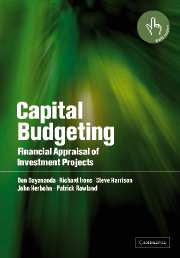Book contents
- Frontmatter
- Contents
- List of figures
- List of tables
- Preface
- 1 Capital budgeting: an overview
- 2 Project cash flows
- 3 Forecasting cash flows: quantitative techniques and routes
- 4 Forecasting cash flows: qualitative or judgemental techniques
- 5 Essential formulae in project appraisal
- 6 Project analysis under certainty
- 7 Project analysis under risk
- 8 Sensitivity and break-even analysis
- 9 Simulation concepts and methods
- 10 Case study in financial modelling and simulation of a forestry investment
- 11 Resource constraints and linear programming
- 12 More advanced linear programming concepts and methods
- 13 Financial modelling case study in forestry project evaluation
- 14 Property investment analysis
- 15 Forecasting and analysing risks in property investments
- 16 Multinational corporations and international project appraisal
- References
- Index
8 - Sensitivity and break-even analysis
Published online by Cambridge University Press: 14 May 2010
- Frontmatter
- Contents
- List of figures
- List of tables
- Preface
- 1 Capital budgeting: an overview
- 2 Project cash flows
- 3 Forecasting cash flows: quantitative techniques and routes
- 4 Forecasting cash flows: qualitative or judgemental techniques
- 5 Essential formulae in project appraisal
- 6 Project analysis under certainty
- 7 Project analysis under risk
- 8 Sensitivity and break-even analysis
- 9 Simulation concepts and methods
- 10 Case study in financial modelling and simulation of a forestry investment
- 11 Resource constraints and linear programming
- 12 More advanced linear programming concepts and methods
- 13 Financial modelling case study in forestry project evaluation
- 14 Property investment analysis
- 15 Forecasting and analysing risks in property investments
- 16 Multinational corporations and international project appraisal
- References
- Index
Summary
In Chapter 7, two methods of dealing with risk in investment analysis were covered. These focused on capturing risk by using an appropriate discount rate, or by employing a certainty equivalent coefficient. The risk-adjusted discount rate method sought to find a discount rate that reflected the comparative risk of the project. The presumption in this type of risk measurement is that the higher the risk, the higher the required rate of return. The certainty equivalent method sought to convert all uncertain future cash flows to their equivalent amounts to be received with certainty, and then to discount these flows at the risk-free rate.
This chapter introduces two mechanical methods for analysing projects under risk. The aim of these methods is to discover which variables (or parameters) have the greatest impact on the project's outcome. The first method is known as sensitivity analysis. In this process, individual forecasted variables are progressively stepped through their pessimistic, most likely and optimistic levels, to determine which variables cause the largest shifts in the project's net present value. For example, management may wish to know whether optimistic or pessimistic unit sales prices have greater impacts than optimistic and pessimistic values of sales growth rates.
The second method is known as break-even analysis. This process determines how low an income variable can fall, or how high a cost variable can rise, before the project breaks even at a net present value of zero.
- Type
- Chapter
- Information
- Capital BudgetingFinancial Appraisal of Investment Projects, pp. 133 - 152Publisher: Cambridge University PressPrint publication year: 2002



